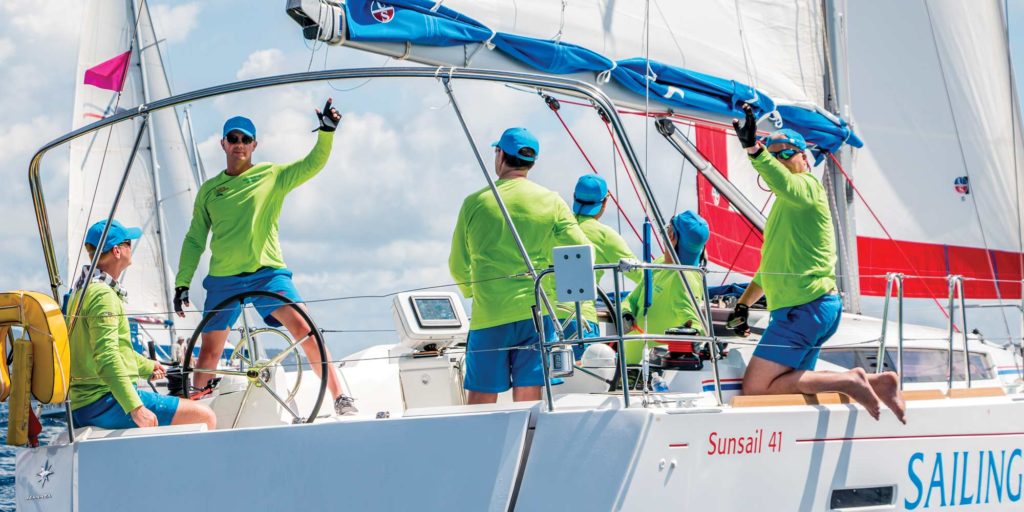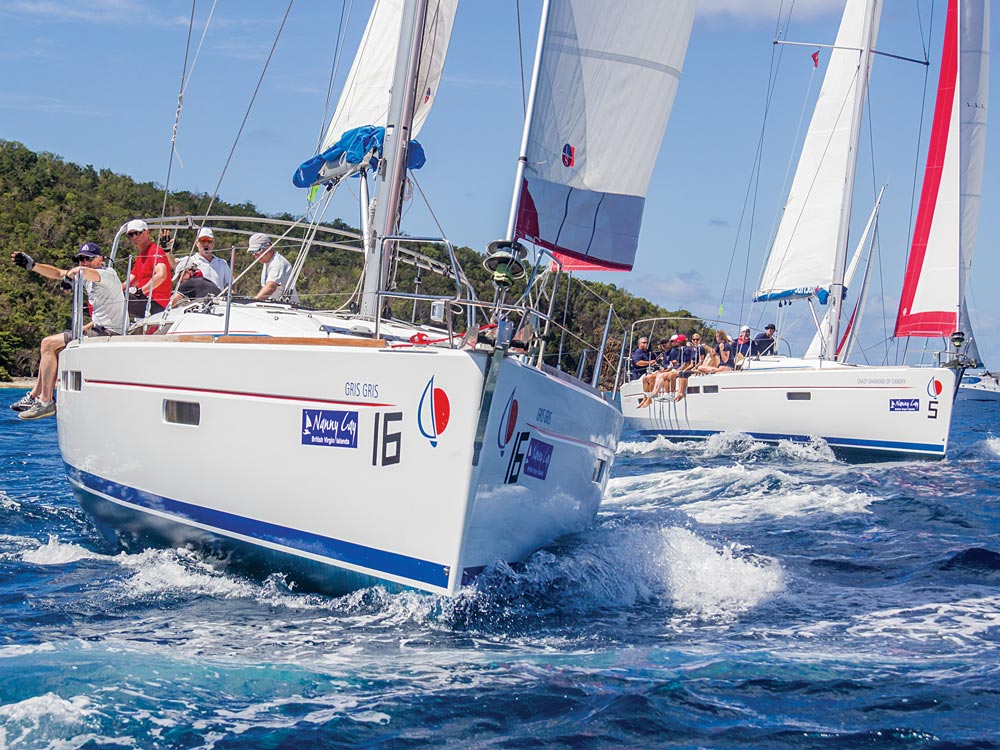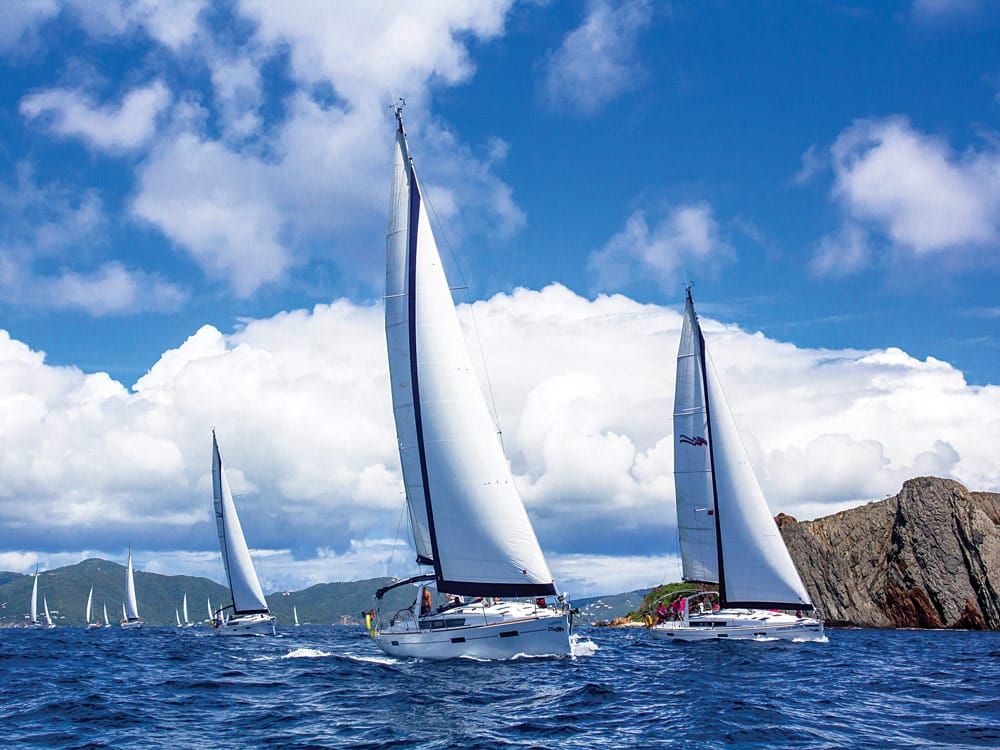
An atmosphere of Caribbean-inspired euphoria, unbridled enthusiasm and — in retrospect — a pinch of overconfidence blew across the cockpit of Aigue Marine, our Sunsail-chartered Beneteau 50, as we sailed from English Harbour to nearby Green Island, just off of Antigua’s eastern flank. The plan was to toss the hook and clean the boat’s ample undercarriage in preparation for the next day’s start of the 2008 edition of Antigua Sailing Week. Given that our crew all had racing experience, and given that we were competing in the regatta’s chubby-hubby bareboat fleet, we naively assumed that our competition would be soft.
Three days and numerous mid-fleet finishes later, we were quickly learning that it takes more than a scrub brush and some late-winter cabin fever to win a Caribbean bareboat regatta, especially with other accomplished racers gunning for the same prize. Fortunately, as we happily discovered, competition can be as stiff or relaxed as each crew chooses to make it, giving sailors of all sailcloths the opportunity to engage in fun-spirited racing on some of the world’s best racecourses.
For sailors who want to do well, however, bareboat racing ace Neil Harvey shares secrets gleaned over 20-plus years of racing — and winning — these storied events.
“Bareboats are a wonderful concept of racing,” says Harvey, a longtime marine-industry veteran and world-famous Australian ocean racer, a few days after winning the 2018 Heineken Regatta’s 10-boat-strong Bareboat 2 division aboard KHS&S Contractors, the Dufour 44 that he and Michael Cannon chartered from Dream Yacht Charters. “You can bring your family and friends — your crew doesn’t have to be rock stars, and the boats are quite comfortable to stay aboard.”
As with all sailboat racing, assembling the right crew is one of the most important pieces of any winning formula, and the key, says Harvey, is to build a core group who are complemented by other sailors of varying experience levels. “We don’t practice together at home beforehand, but we like to practice before the first day of the regatta,” says Harvey, adding that the KHS&S Contractors crew used the regatta-within-a-regatta Gill Commodore’s Cup at this year’s Heineken regatta as their warm-up.

Much like our bottom-scrubbing sojourn to Green Island aboard Aigue Marine, Harvey and company arrive a day or two before the regatta and carefully comb through the boat. Their checklist includes a thorough bottom scrub (taking particular care to clean the leading edges of all appendages and the keel bulb’s underside), tuning the mast and inspecting the running rigging. Here, Harvey suggests dividing the crew into “bow,” “mast” and “mid-deck/cockpit” teams that are responsible for inspecting every individual piece of equipment, ferreting out broken sheaves and chaffed halyards and sheets, taping off lifeline fittings and gates, and taping over mast-mounted cleats that could otherwise snag jib sheets.
Most charter boats are equipped with a midboom traveler, and Harvey recommends carefully rinsing out the traveler car and its bearings, track and bearing races with fresh water and dish soap, then slacking all control lines and running the car back and forth on the track to remove all salt crystals before a final freshwater rinse. “Then, I put a little bit of McLube or WD-40 in the traveler car to condition the ball bearings,” says Harvey, who also advises polishing the compass prisms on both helms.
Next, Harvey suggests pasting white electrical tape next to each of the jib tracks — port and starboard — and numbering each pin-stop hole for easy visual reference. Also, if your boat’s jib-furling line leads aft to a primary winch, Harvey suggests re-leading it from the bow through an empty slot in a cabin-top organizer to a rope clutch and then to a cabin-top winch, which allows you to shorten sail if the primary winch is otherwise occupied.
Following the rules is an important part of mastering any game, and it’s critical that multiple crewmembers have read the regatta’s notice of race and are familiar with its sailing instructions. While most Caribbean regattas are governed by the Racing Rules of Sailing and handicap each boat using the Caribbean Sailing Association’s handicap formula, some events, including the St. Maarten Heineken Regatta, employ their own bareboat rules. In all cases, it’s critical to understand the rules and penalties (such as 360- or 720-degree penalty turns), and while no one wants to be penalized and go into “the room,” Harvey suggests taping a protest flag to the backstay for fast deployment, just in case. “It’s a fabulous set of rules, and they made it even for everyone,” says Harvey about the even playing fields found in the bareboat fleets.
Once under sail and in full upwind trim, Harvey recommends marking your outhaul and halyard positions with a magic marker and then adding additional marks a few inches behind the clutch to serve as rough-trim reference points when quickly switching gears from upwind mode to reaching or running.

“I joke with the charter companies that I’ll be disappointed if the boat doesn’t come back in better condition than when we took it,” Harvey says of his pre-race setup work.
Next, the task becomes one of employing the fastest boathandling tactics. This starts, says Harvey, by backing down the boat minutes before your starting gun to remove any errant seaweed or kelp, while also ensuring that the engine’s gear shifter is in its neutral position.
Sails come next, and the first commandment of bareboat racing is never to reef the mainsail in less than 28 knots, says Harvey. “Full-batten sails with internal slugs make it almost impossible to pull the sail down without heading into the wind,” Harvey says, adding that swept-back spreaders make it extremely hard to re-hoist the main after rounding the windward mark. “Instead, it’s better to go with a full main and a [partially] rolled-up jib because this opens the slot, letting you lower the traveler in puffs.” Similarly, when pounding into bathtub-warm seas and preparing to tack, Harvey often puts four or five reefing rolls into the headsail and then unwinds this cloth on the next board.
While roller-reefing the headsail — rather than the mainsail — is fast, don’t forget to adjust your jib cars to achieve the correct sail shapes. Here, Harvey says, a smart move involves using the end of your jib halyard as a temporary jib sheet (running from the clew to a rail cleat) while adjusting a jib car, and to adjust the port and starboard jib cars at the same time — using the numbered tape as a fast reference — so the helmsman can tack as needed.
Carrying a full mainsail in a fresh Caribbean breeze requires active trimmers, and Harvey stations crew on the port and starboard traveler-control lines, which are never cleated off. This allows the crew to instantly crack the traveler off in puffs — keeping the boat on its feet and reducing weather helm — and quickly trim it to weather during lulls.
As with all sailboat racing, it’s important to watch the breeze and to react by “changing gears” as necessary, using controls such as sheets, outhaul and halyard tension, and movable ballast. “We have two rules when going to weather,” Harvey says. “We prefer you sit on the windward rail, but it’s OK to lean against the cabin side, and if you go below, you’d better come up with a few beers.”
Downwind tactics are eased considerably by the fact that bareboat fleets don’t use spinnakers, and Rule 49.2 of the Racing Rules of Sailing limits how far outside the lifelines crews can reach while holding sheets, but fast crews will pay close attention to the boat’s heel angle and attitude. “We’ll move two bodies to leeward [when sailing downwind],” Harvey says. “And we move all weight forward of the shrouds to get the stern out of the water.”
While spinnakers are out, sailing wing-on-wing is fast and class legal. In light to moderate airs, Harvey and his crew ease the mainsail all the way out and tie the boom to the cap shroud (using duct tape or a towel to protect it from damage), and move all crewmembers to the headsail side of the boat to help encourage the jib to fill. Also, steering 5 degrees to the lee is quick when sailing deep angles, Harvey says.
While fairly obvious, it’s important to avoid competitors’ dirty air and adverse currents, just like on any racecourse. However, Harvey points out that the equatorial current generally flows through the Caribbean in a westward direction (eventually becoming the Gulf Stream). Here, smart tacticians will monitor the difference between the vessel’s speed over water and its speed over ground, and will leverage this information.
Likewise, wave angles relative to the breeze are another important consideration, and Harvey suggests using the roller-reefing headsail to help deal with offset seas. For example, when negotiating the Anguilla Passage at the Heineken Regatta, where the seas are generally skewed a bit to the prevailing breeze, Harvey suggests putting in four or five headsail rolls when tacking into the waves, and then shaking out one or two rolls on the opposite board.
Harvey’s final pieces of advice are ones that we fortunately heeded aboard Aigue Marine, namely that the Caribbean sun is hot and intensely bright, especially for anyone accustomed to northern climes, so proper hydration and sun protection are critical. Consider carrying large water jugs to refill individual bottles, and definitely use strong sunscreen and SPF-rated clothing, the latter of which can be ordered with team livery.
While chartering a boat and enjoying a fantastic week of sailing at a Caribbean regatta is relatively easy (see “Charter Considerations,” above), winning is another matter. Still, Harvey and his core group of “nuclears” have used this playbook to collect more than their fair share of racecourse hardware over the past 20-plus years.
“It’s the most enjoyable keelboat racing I’ve ever done,” Harvey says, adding that he often optimizes his experience by tagging on a few days of cruising before or after racing. “And it’s an affordable way to do a major Caribbean regatta.”
David Schmidt is CW’s electronics editor.
Charter Considerations
Given bareboat racing’s popularity, Harvey recommends booking your reservations as early as possible to secure your spot on the starting line. Josie Tucci, the vice president of sales and marketing at Travelopia Marine (owners of The Moorings and Sunsail), advises that prospective customers must provide a sailing resume detailing their qualifications, pay a nonrefundable race-supplement fee, put down a refundable damage deposit and obtain the charter company’s permission to go racing.
“We’ve had fleets participating in the BVI Spring Regatta, St. Maarten Heineken Regatta and Antigua Sailing Week since their inception,” Tucci says. “We have a big contingent of active customers who enjoy the racing circuit in the Caribbean and can’t bring their own boats down but who still want to enjoy the awesome breezes, sunshine and turquoise waters. It’s nonspinnaker racing, so it’s accessible for all and a lot of fun.” Finally, Tucci says, “If you book your race package through us, we’ll handle registration with the regatta organizers for you.”








